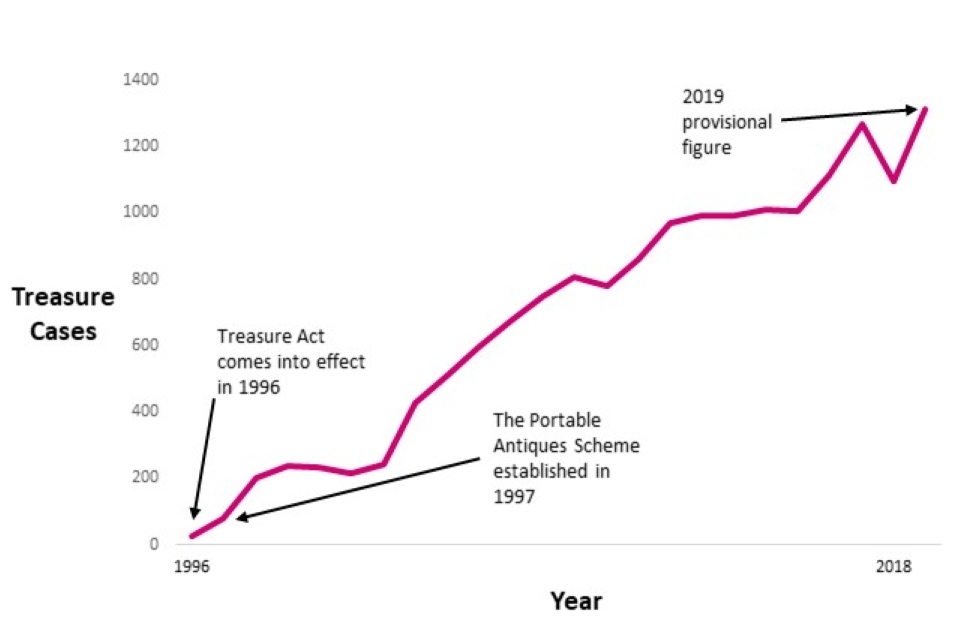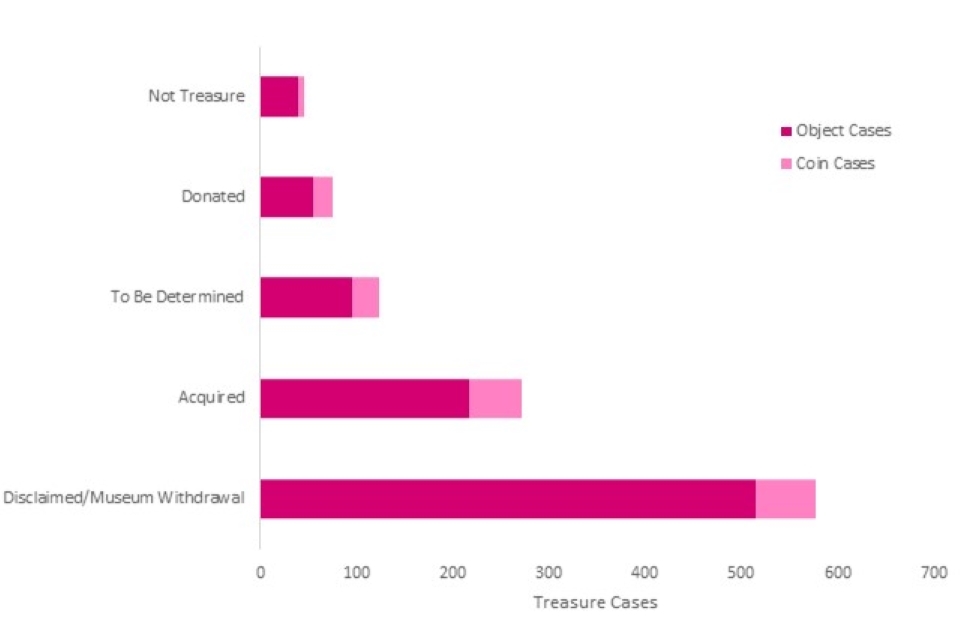Reported Treasure Finds 2018/19 Statistical Release
Published 3 February 2021
Applies to England, Northern Ireland and Wales
1. Headline Figures
2019
- The provisional figure for reported treasure finds in 2019 is 1,311, the highest figure on record. This makes 2019 the sixth year in a row when reported treasure finds exceeded 1,000.
2018
- There were 1,094 reported treasure finds in total across England, Wales, and Northern Ireland.
- Of reported treasure finds 921 cases (84%) were object cases[footnote 1] and 173 finds (16%) were coin cases.
- 348 finds were acquired by, or donated to museums (272 object cases, 76 coin cases)
- Of the total 1,094 reported treasure finds, 1,051 (96%) of these were discovered by metal detecting.
1.1 Figure 1: Number of reported treasure finds in England, Wales and Northern Ireland, 1996 – 2019 (provisional).

2. Total reported treasure finds in England, Wales and Northern Ireland[footnote 2][footnote 3]
In 2019, the provisional number of reported treasure finds was 1,311. This is the sixth year in a row, and for the sixth time since the Treasure Act of 1996[footnote 4] replaced the old common law of Treasure Trove in England, Wales and Northern Ireland, when treasure finds exceeded 1,000.
The total treasure find for England were 1,262 with a further 45 in Wales and 4 in Northern Ireland. It should be noted that there are additional restrictions on searching for archaeological objects in Northern Ireland, imposed by the Historic Monuments and Archaeological Objects (NI) Order 1995.
In 2018, reported treasure finds were 1,094[footnote 5] , representing a total of 20,906 artefacts (objects and coins). A ‘treasure find’ can be made of multiple artefacts which explains the difference between the number of artefacts and the number of reported treasure finds. The total treasure finds were 1,068 for England, 20 for Wales, and 6 for Northern Ireland.
3. Reported finds by Location, 2018 & 2019 (provisional)
Among Government regions in England, the South East of England had the highest number of reported finds at 322, followed by the East of England with 285 finds. London had the fewest reported finds with 15. The second lowest region was the North East with 17.
3.1 Figure 2: Reported treasure finds by country and English region, 2019 (provisional)

In 2019, by county, the largest number of treasure finds in England, Wales and Northern Ireland was in Hampshire with 104 cases (8% of total finds) whilst in 2018, the largest number of treasure finds in England, Wales and Northern Ireland was in Norfolk with 103 cases (9% of total finds).
4. Characteristics of reported finds, 2018
We are able to provide characteristics of the treasure finds from 2018, reporting on the object type discovered, the period of history it originates from and the number of pieces of treasure museums in the UK were interested in acquiring. This data is not yet available for 2019 due to it still being provisional. The next statistical release (due to be published in Autumn 2021) will cover characteristics for 2019 treasure finds.
There were 1,094 treasure finds reported in 2018 (921 object cases and 173 coin cases). Of these cases:
-
272 were acquired by museums (217 object cases, 55 coin cases)[footnote 6]
-
76 were donated to museums (55 object cases, 21 coin cases) allowing them to be acquired by museums at no (or reduced) public cost, 72% (55) of these were object cases.
-
577 were withdrawn or disclaimed by museums (515 object cases, 62 coin cases)[footnote 7]
-
46 did not meet the definition for treasure (39 object cases, 7 coin cases)
-
123 to be confirmed (95 object cases, 28 coin cases)
Of these finds, the two largest acquisitions were 19 cases obtained by the British Museum and 17 cases obtained by Dorset Country Museum (5% each).
Under the Treasure Act 1996, the Secretary of State has the power to disclaim a find, even when the find meets the definition of treasure under the Act. This can occur at any point in the process e.g. if a museum withdraws its interest in acquiring a find, and no other museum expresses an interest.
The total number of finds which have been shown to meet the definition for treasure in 2018 was 925. This includes acquired, donated and disclaimed/museum withdrawal items.
4.1 Figure 3: Reported treasure finds, by change in ownership: England, Wales and Northern Ireland, 2018

Around a third (32%) of treasure cases in 2018 were from the post-medieval period (317 object cases and 36 coin cases) and nearly a quarter (25%) were from the medieval period (239 object cases and 37 coin cases).
4.2 Figure 4: Reported treasure cases by period: England, Wales and Northern Ireland, 2018

5. Mode of discovery
The majority (96%) of treasure finds in 2018 were discovered by metal detecting, similar to the proportion in 2017. In 2018, a further 3% (29 cases) were archaeological finds and 1% (7 cases) were chance finds.
In 2019/20, according to the Taking Part Survey, an estimated 2% of adults (16+) in England said they had taken part in metal detecting at least once in the 12 months prior to interview[footnote 8] . This is a similar level to participation in 2018/19. The rate varies regionally.
Footnotes
-
An object case is a find of any non-coin artefact ↩
-
A number of finds reported in 2019 have not been resolved and it is not possible to provide a breakdown of factors such as period and disposition (i.e. change in ownership) in this release. This final breakdown will be provided in the Treasure Finds Statistical Release in 2021 which will cover the treasure finds for 2019 and provisional figures for 2020. ↩
-
Data for Scotland is collated under the Scottish Treasure Trove system available at the Scotland treasure trove web page ↩
-
The Treasure Act 1996 replaced the common law of treasure trove in England, Wales and Northern Ireland. Scotland has a separate law of treasure trove and thus isn’t covered in this statistical release. ↩
-
This figure has been amended from the provisional 2018 figure (1,096) reported in last year’s release as the number of finds had not yet been resolved at the time of publication ↩
-
Acquired cases covers finds that have been acquired as well as finds where museums have made an expression of interest, but have not yet acquired. ↩
-
Disclaimed/museum withdrawal cases are those case where the secretary of state disclaims title for the find prior to inquest, or where an inquest is held declaring the find to be treasure (and therefore vesting in the Crown) but where a museum subsequently fails to acquire the find and it is returned to the finder or landowner. ↩
-
Survey participants were asked whether they had participated in metal detecting within the last 12 months, therefore, these statistics are not intended to capture an estimate of ‘regular’ metal detectorists or those who are members of metal detecting clubs within England. ↩
